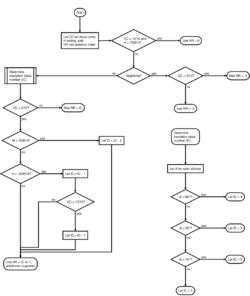Earth:Turner stability class
From HandWiki
The Turner stability class or Turner stability index is a classification of atmospheric stability over an interval of time based on measurements of surface-level wind speed and net solar radiation. Classes range from 1 (most unstable) to 7 (most stable). The Turner stability class system was devised by D. B. Turner as a modification of the Pasquill stability class system.[1] The following table is used to determine the Turner stability class for a given wind speed and net solar radiation:
| Wind speed (knots) |
Net radiation index | ||||||
|---|---|---|---|---|---|---|---|
| 4 | 3 | 2 | 1 | 0 | -1 | -2 | |
| 0, 1 | 1 | 1 | 2 | 3 | 4 | 6 | 7 |
| 2, 3 | 1 | 2 | 2 | 3 | 4 | 6 | 7 |
| 4, 5 | 1 | 2 | 3 | 4 | 4 | 5 | 6 |
| 6 | 2 | 2 | 3 | 4 | 4 | 5 | 6 |
| 7 | 2 | 2 | 3 | 4 | 4 | 4 | 5 |
| 8, 9 | 2 | 3 | 3 | 4 | 4 | 4 | 5 |
| 10 | 3 | 3 | 4 | 4 | 4 | 4 | 5 |
| 11 | 3 | 3 | 4 | 4 | 4 | 4 | 4 |
| ≥ 12 | 3 | 4 | 4 | 4 | 4 | 4 | 4 |
The net radiation index is determined by following a procedure (see flowchart) that takes into account the cloud cover, ceiling height, and solar altitude.
References
- ↑ Turner, D. Bruce (1964). "A Diffusion Model for an Urban Area". Journal of Applied Meteorology 3 (1): 83–91. doi:10.1175/1520-0450(1964)003<0083:ADMFAU>2.0.CO;2. Bibcode: 1964JApMe...3...83T. https://journals.ametsoc.org/view/journals/apme/3/1/1520-0450_1964_003_0083_admfau_2_0_co_2.xml. Retrieved July 10, 2021.
- ↑ Turner, D. Bruce (1961). "Relationships Between 24-Hour Mean Air Quality Measurements and Meteorological Factors in Nashville, Tennessee". Journal of the Air Pollution Control Association 11 (10): 483–489. doi:10.1080/00022470.1961.10468029. PMID 13923192. https://www.tandfonline.com/doi/abs/10.1080/00022470.1961.10468029. Retrieved 2021-07-10.
 |


